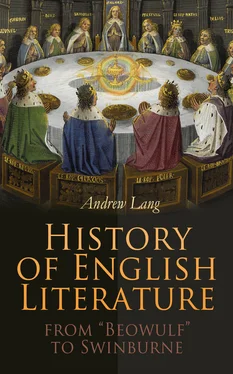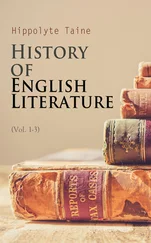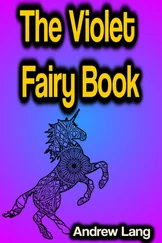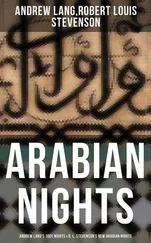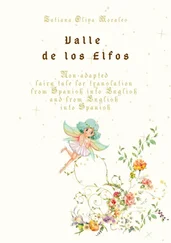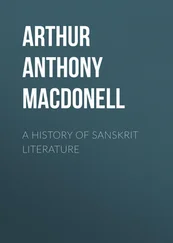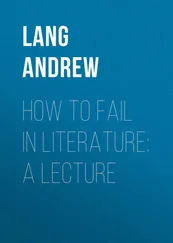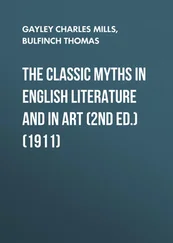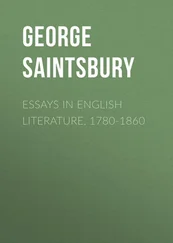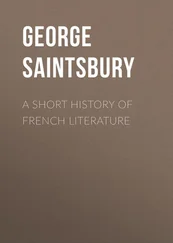Other religious books of the time are the "Poema Morale," in lines of fourteen syllables ending in a double rhyme, as lorè, morè, deedè, redè , and a new metrical paraphrase of Genesis and Exodus. The story is told with some vivacity, in rhyming couplets of eight syllables.
The drempte pharaoh king a drem
That he stod by the flodes strem
And the then ut come VII neat
Everile wel swithe fet and gret,
And VII lene after the.
In places the metre of Coleridge's "Christabel," which was the model of Scott's "Lay of the Last Minstrel," is recognized in the casual couplets, thus:—
For sextenè yer Joseph was old
Quane he was into Egypte sold.
But it is a far cry from this to
The feast was over in Branksome tower;
and the metre, when Scott's "Lay" appeared, seemed to be a novelty.
The Owl and the Nightingale.
in rhyming eight-syllable couplets, seems to have been written about 1250 (?). The theme is a debate , in the fashion of French poetry, between the owl and the nightingale, as to the comparative merit of their songs. The nightingale, deserting her art, rather feebly asserts the moral influence of her own music, and attacks the owl in a very personal strain of invective, reflecting on his want of good looks, and on his taste in food. We are far indeed from Keats's "Ode to the Nightingale", "If you are so great a teacher," replied the owl, "why do you not sing to men in Ireland, Norway, and Galloway?" La Fontaine might have made a witty poem on the dispute of the owl and the nightingale, but the poet was not a wit, and made a poor use of his opportunities. He is supposed, but not with certainty, to have been Nicholas of Guildford, who is credited with being neglected by the Bishop in the distribution of patronage.
The owl quotes the "Proverbs of King Alfred," of which there is a thirteenth century collection in rhyme; there are also the "Proverbs of Hendyng": the latter in stanzas of six lines each, the first two rhyming with each other, as do the last two, while the third line rhymes with the sixth: a very popular jingle.
Far more interesting than these things, whether moral or religious, are the rhyming songs, the voice of the English people, laymen, not priests, the love lyrics (1300?), for example, one on Alison, beginning
Bytuene Mershe ant Averil
When spray biginneth to springe,
The lutel fowl hath hire wyll
On hyre lud to synge,
each stanza ending
From alle wymen mi loue is lent
Ant lyht on Alisoun.
This is the first sweet English love-song that has escaped the ruins of time. Everyone knows by heart
Sumer is icumen in;
and
Blow, northerne wynd,
Send thou me my suetyng,
reminds us of
O gentle wind that bloweth south
From where my love repaireth.
There were all the sounds and scents of spring in the hearts and songs of the poets:—
Lenten is come with love to toune,
With blosmen ant with briddes roune,
That all this blisse bryngeth.
This metre came to be used in telling stories in verse, a purpose for which it is not well fitted. But truly English poetry, with rich re-echoing rhymes and many forms of verse, is awake at last.
To politics as well as to love and the delights of spring the Muse of the people was alive. The popular hatred of Richard of Cornwall, brother of Henry III, expressed itself thus after the battle of Lewes (1264). The English is here but slightly modernized:—
Be thou lief, be thou loth, Sir Edward,
Thou shalt ride spurless on thy lyard
All the right way to Doverward
Shalt thou never more break forward,
Edward, thou did'st as a shreward,
Forsook thine uncle's lore,
Richard, though thou be ever trichard
Trick shalt thou never more.
(A lyard is a grey, spoken of a horse,
The Dinlay snaws were ne'er so white
As the lyart locks o' Harden's hair,
says the ballad of "Jamie Telfer".)
The English view of Wallace, the patriot knight of Scotland, cruelly executed, is thus set forth:—
To warn all the gentlemen that be in Scotland
The Wallace was drawn, thereafter hanged,
Beheaded alive, his bowels burned,
The head to London Bridge was sent,
To abide
After Simon Frysel,
That was traitor and fickle
And known full wide.
(Frysel or Fraser; a later Simon Fraser, Lord Lovat of 1745, was traitor and fickle enough.)
By no means so lively, though useful in its day, is the very long metrical chronicle (about 1300) of Robert of Gloucester, whether it be by two hands or by one. One, at least, named Robert, was living at the dates of a great Oxford town and gown row, which he describes, and of the battle of Evesham (1265). He was fortunately not nearer than a distance of thirty miles from that stricken field, and records his own fear of a dense darkness which prevented the monks from reading service in church. Robert dwelt in Gloucester, as his minute local allusions prove. He began his chronicle by versifying the fabulous work of Geoffrey of Monmouth, but put into it not a glimmer of the poetry of Layamon. For the rest, till he reached his own time, he copied Henry of Huntingdon, William of Malmesbury, and "Lives of the Saints".
Robert's learned modern editor, Mr. Aldis Wright, outworn by all the tediousness which the poet bestows on us, says "as literature, the book is as worthless as twelve thousand lines of verse without one spark of poetry can be". But Robert's praises of England, "a wel god loud," and of English folk, so clean and handsome, have a sound spontaneous note of patriotism, and there is a swing in what Mr. Wright cruelly styles his "doggerel verse in ballad metre," which is not to be despised. To be sure he has, without knowing it, several different sorts of verse, and is nearly as irregular as Layamon himself, in his measures. His readers would not be offended by these defects, and they learned from him, with a great deal of inaccurate history, a sense of pride in their country, and to speak English, though the nobles and gentry, he says, spoke French.
A book in verse about twice as long as the lengthy world-chronicle of Robert is the "Cursor Mundi," "the Over-Runner of the World". The author, like the makers of many pretty lyrics on religious subjects, perceived that people preferred songs to sermons, and romance to homilies. To modernize his language
Men yearn jests to hear
And romances read in divers mannere.
He gives the themes of the romances, "Matter of Rome"—which includes all antiquity, Troy, and Greece as well as Rome—"Matter of Britain," the stories of Arthur and his Knights—and "Matter of France," concerning Charlemagne, and his Twelve Peers. Nothing is in fashion but love and lovers: but this poet will sing of Her whose love never fails, namely Our Lady. He begins before Satan and his angels fell, and goes on endlessly, yet, to his readers, perhaps not tediously, for he enlivens the Biblical narrative with legends to the full as fantastic as could be found in any romance. There is the story of how Moses found, through a dream, three wands that grew from three pips placed under Adam's tongue. David, through another dream, found these wands in the grave of Moses, which, like that of Arthur, "is a mystery to the world". The wands turned ugly black Saracens into handsome white men: the branches grew into a tree, and round that tree were thirty circles of silver. The wood was made into the True Cross, and Judas received the thirty pieces of silver. The most absurd tales are told of the boyhood, by no means exemplary, of our Lord, variegated by miracles not wholly beneficent.
Читать дальше
